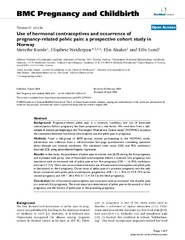Use pattern for contraceptive implants in Norway
Permanent link
https://hdl.handle.net/10037/10408Date
2016-10-19Type
Journal articleTidsskriftartikkel
Peer reviewed
Abstract
Material and methods: In a cross-sectional design, we estimated the annual number of users by calculating doses sold per 1000 women-years in the Norwegian Prescription Database for the years 2006-2012. For each contraceptive method, we calculated on an annual basis a proportion of defined daily doses (DDDs) of all hormonal contraceptives in five years age groups. Data were analyzed in SPSS version 22, with chi-square test, t-test, and survival analysis.
Results: Sales from pharmacies for contraceptive implants more than doubled over the study years and was consistently higher in the younger age groups. The collection rate was 9.3 per 1000 women in 2012, when implant sales amounted to 2.4% of all daily doses of hormonal contraceptives sold. General practitioners and doctors with no specialty were the major prescribers to starters of contraceptive implants, whereas gynecologists prescribed nearly 12% of the volume, a higher proportion to women > 35 years of age than younger women. The cumulative proportions of continued users at 6-, 12-, 24-, and 36-months were 96.1%, 78.6%, 51.9%, and 34.9%, significantly lower for users who had doctors with no specialty as prescribers. At end of first expiration period, 21% of starters continued using implants.
Conclusion: Implants play a minor role in the overall use of hormonal contraception in Norway. One in five starters continue as long-term users.
Description
Publisher
John Wiley & Sons Ltd.Citation
Øvre-Eide V, Skjeldestad FE. Use pattern for contraceptive implants in Norway. Acta Obstet Gynecol Scand 2016; 95:1244–1250.Metadata
Show full item recordCollections
Related items
Showing items related by title, author, creator and subject.
-
Does proximity of women to facilities with better choice of contraceptives affect their contraceptive utilization in rural Ethiopia?
Shiferaw, Solomon; Spigt, Mark; Seme, Assefa; Amogne, Ayanaw; Skrøvseth, Stein Olav; Desta, Selamawit; Radloff, Scott; Tsui, Amy; Dinant, Geert-Jan (Journal article; Tidsskriftartikkel; Peer reviewed, 2017-11-13)Background:<br>There is limited evidence of the linkage between contraceptive use, the range of methods available and level of contraceptive stocks at health facilities and distance to facility in developing countries. The present analysis aims at examining the influence of contraceptive method availability and distance to the nearby facilities on modern contraceptive utilization among married women ... -
Use of hormonal contraceptives and occurrence of pregnancy-related pelvic pain. A prospective cohort study in Norway
Weiderpass, Elisabete; Kumle, Merethe; Alsaker, Elin; Lund, Eiliv (Journal article; Tidsskriftartikkel; Peer reviewed, 2004-06-22)Background: Pregnancy-related pelvic pain is a common condition, and use of hormonal contraceptives before pregnancy has been proposed as a risk factor. We used data from a sub-sample of women participating in the "Norwegian Women and Cancer study" (NOWAC) to assess the association between hormonal contraceptive use and pelvic pain in pregnancy. Methods: From a sub-group of 2078 parous women ... -
Family planning knowledge and current use of contraception among the Mru indigenous women in Bangladesh: a multivariate analysis
Thorvaldsen, Gunnar; Islam, Rakibul (Journal article; Tidsskriftartikkel; Peer reviewed, 2012)Background: This article aims to understand the family planning (FP) knowledge and current use of contraception and its predictors among women of the Mru people – the most underprivileged indigenous community in Bangladesh. Methods: In this study, 374 currently married Mru women were interviewed and selected purposively from three upazilas (administrative subdistricts) of the Bandarban area, where ...


 English
English norsk
norsk


